Packaged foods company Hormel (NYSE:HRL) reported Q1 FY2024 results topping analysts' expectations, with revenue flat year on year at $3.00 billion. The company's full-year revenue guidance of $12.35 billion at the midpoint also came in 1.4% above analysts' estimates. It made a non-GAAP profit of $0.41 per share, improving from its profit of $0.40 per share in the same quarter last year.
Hormel Foods (HRL) Q1 FY2024 Highlights:
- Revenue: $3.00 billion vs analyst estimates of $2.91 billion (2.8% beat)
- EPS (non-GAAP): $0.41 vs analyst estimates of $0.34 (20.4% beat)
- The company reconfirmed its revenue and EPS guidance for the full year
- Free Cash Flow of $356.8 million, up 64.1% from the previous quarter
- Gross Margin (GAAP): 17%, up from 16.7% in the same quarter last year
- Sales Volumes were up 4% year on year
- Market Capitalization: $16.86 billion
Best known for its SPAM brand, Hormel (NYSE:HRL) is a packaged foods company with products that span meat, poultry, shelf-stable foods, and spreads.
Established in 1891 by George A. Hormel, the company started as a meatpacking operation. Throughout its history, Hormel has grown its business and expanded its portfolio through organic development as well as through mergers and acquisitions. The 1936 acquisition of SPAM was transformative, as was the 2013 deal to bring Skippy peanut butter into the portfolio.
In addition to its namesake brand, SPAM, and Skippy, the company also boasts the Planters (nuts), Applegate Farms (meats), Jennie-O (meats), and Justin’s (spreads and snacks) brands. Hormel caters to low to middle-income households seeking convenience through trusted brands. The heads or caretakers of these households are usually busy and don’t have the time to cook meals or prepare snacks from scratch. The company’s products add convenience to everyday life, and they are often brands that customers have been eating since childhood.
Hormel products enjoy wide distribution. Supermarkets and grocery stores are the most common sellers of the company’s products, but consumers can also find brands such as SPAM and Skippy in mass merchandisers and discount retailers that carry food.
Packaged Food
Packaged food stocks are considered resilient investments because people always need to eat. These companies therefore can enjoy consistent demand as long as they stay on top of changing consumer preferences. But consumer preferences can be a double-edged sword, as companies that aren't at the front of trends such as health and wellness and natural ingredients can fall behind. Finally, with the advent of the social media, the cost of starting a brand from scratch is much lower, meaning that new entrants can chip away at the market shares of established players.
Competitors in packaged food with a focus on meat include Kraft Heinz (NASDAQ:KHC), Tyson (NYSE:TSN), and Pilgrim’s Pride (NASDAQ:PPC).Sales Growth
Hormel Foods is one of the larger consumer staples companies and benefits from a well-known brand, giving it customer mindshare and influence over purchasing decisions.
As you can see below, the company's annualized revenue growth rate of 7.8% over the last three years was decent for a consumer staples business.
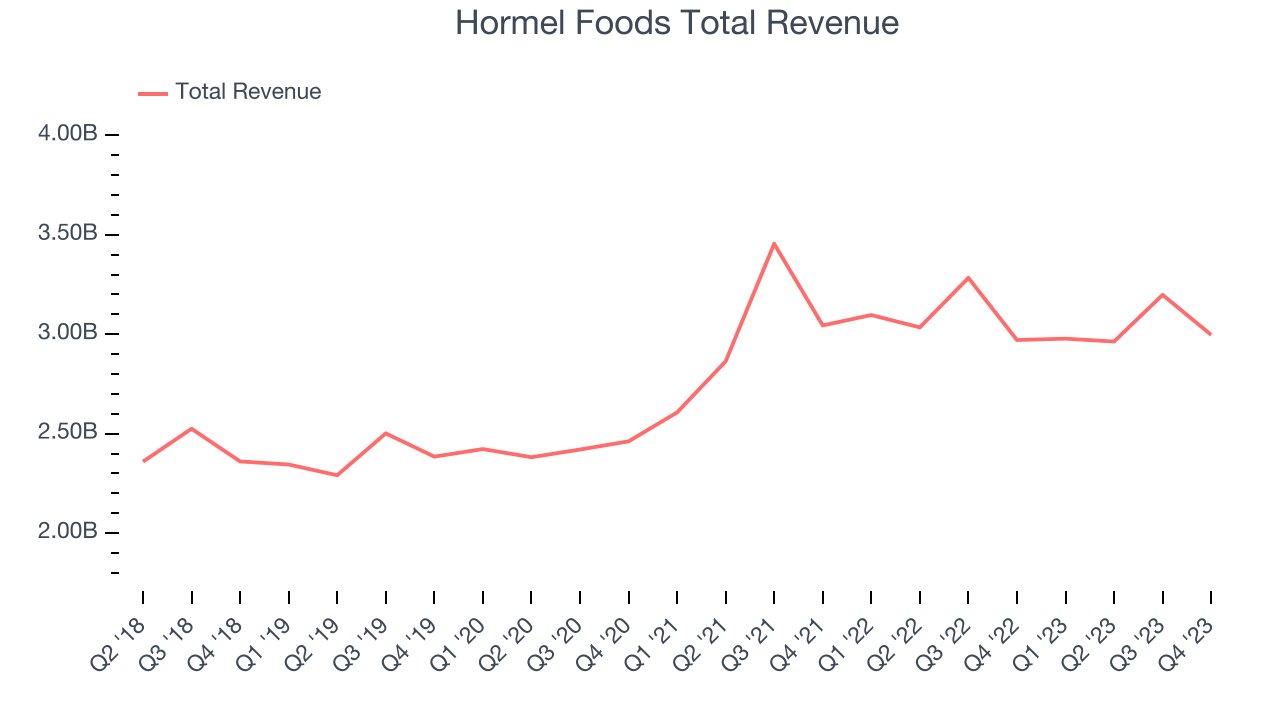
This quarter, Hormel Foods reported decent year-on-year revenue growth of 0.9%, and its $3.00 billion in revenue topped Wall Street's estimates by 2.8%. Looking ahead, Wall Street expects revenue to remain flat over the next 12 months, a deceleration from this quarter.
Volume Growth
Revenue growth can be broken down into changes in price and volume (the number of units sold). While both are important, volume is the lifeblood of a successful staples business as there’s a ceiling to what consumers will pay for everyday goods; they can always trade down to non-branded products if the branded versions are too expensive.
Hormel Foods's average quarterly sales volumes have shrunk by 5% over the last two years. This decrease isn't ideal because the quantity demanded for consumer staples products is typically stable. 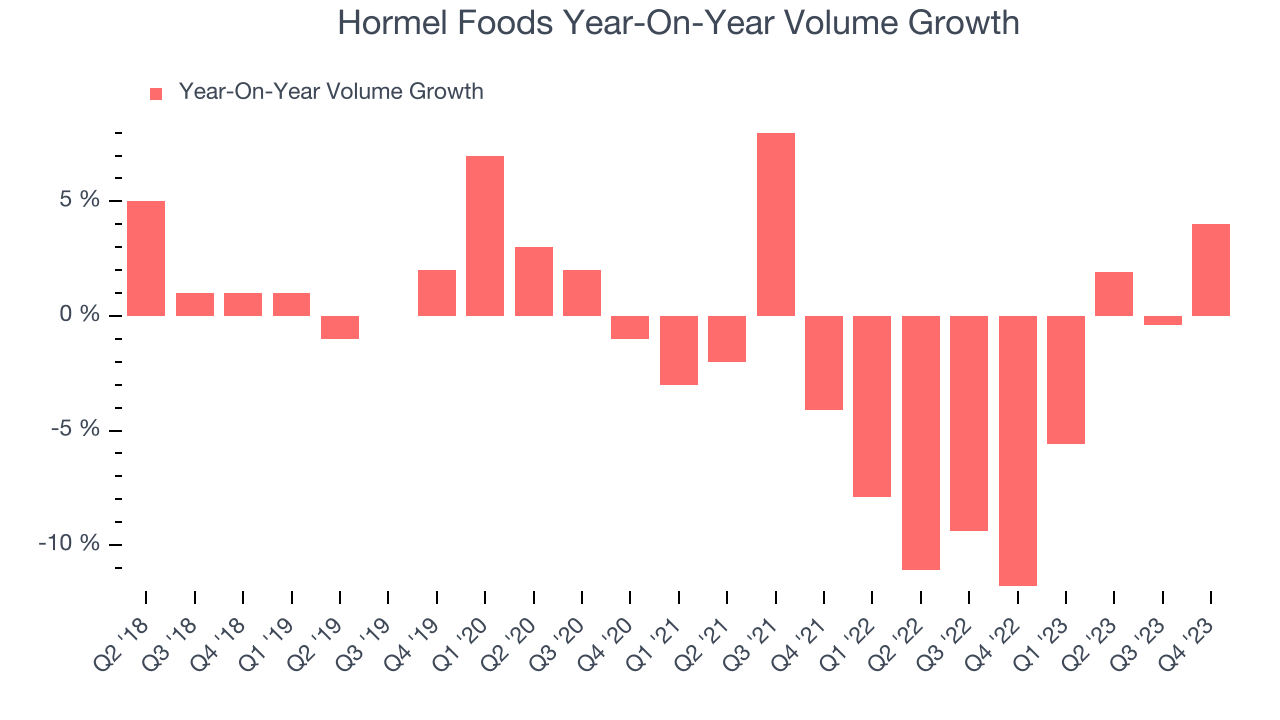
In Hormel Foods's Q1 2024, sales volumes jumped 4% year on year. This result was a well-appreciated turnaround from the 11.8% year-on-year decline it posted 12 months ago, showing the company is heading in the right direction.
Gross Margin & Pricing Power
We prefer higher gross margins because they make it easier to generate more operating profits.
Hormel Foods's gross profit margin came in at 17% this quarter, in line with the same quarter last year. That means for every $1 in revenue, a chunky $0.83 went towards paying for raw materials, production of goods, and distribution expenses. 
Hormel Foods has poor unit economics for a consumer staples company, leaving it with little room for error if things go awry. As you can see above, it's averaged a paltry 16.9% gross margin over the last two years. Its margin has also been trending down over the last year, averaging 3% year-on-year decreases each quarter. If this trend continues, it could suggest a more competitive environment where Hormel Foods has diminishing pricing power and less favorable input costs (such as raw materials).
Operating Margin
Operating margin is an important measure of profitability accounting for key expenses such as marketing and advertising, IT systems, wages, and other administrative costs.
In Q1, Hormel Foods generated an operating profit margin of 9.5%, in line with the same quarter last year. This indicates the company's costs have been relatively stable.
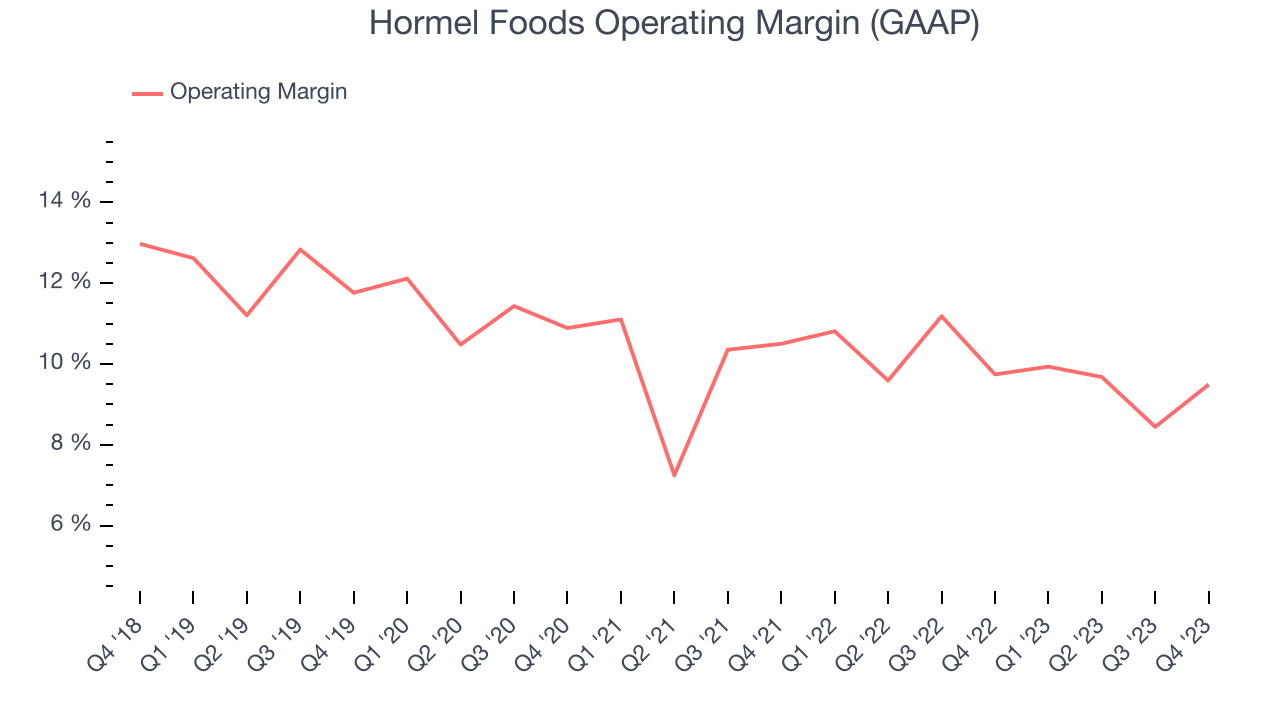 Zooming out, Hormel Foods has done a decent job managing its expenses over the last eight quarters. The company has produced an average operating margin of 9.9%, higher than the broader consumer staples sector. On top of that, its margin has remained more or less the same, highlighting the consistency of its business. The company's operating profitability was particularly impressive because of its low gross margin, which is mostly a factor of what it sells and takes tectonic shifts to move meaningfully. Companies have more control over their operating margins, and it signals strength if they're high when gross margins are low (like for Hormel Foods).
Zooming out, Hormel Foods has done a decent job managing its expenses over the last eight quarters. The company has produced an average operating margin of 9.9%, higher than the broader consumer staples sector. On top of that, its margin has remained more or less the same, highlighting the consistency of its business. The company's operating profitability was particularly impressive because of its low gross margin, which is mostly a factor of what it sells and takes tectonic shifts to move meaningfully. Companies have more control over their operating margins, and it signals strength if they're high when gross margins are low (like for Hormel Foods).EPS
These days, some companies issue new shares like there's no tomorrow. That's why we like to track earnings per share (EPS) because it accounts for shareholder dilution and share buybacks.
In Q1, Hormel Foods reported EPS at $0.41, up from $0.40 in the same quarter a year ago. This print beat Wall Street's estimates by 20.4%.
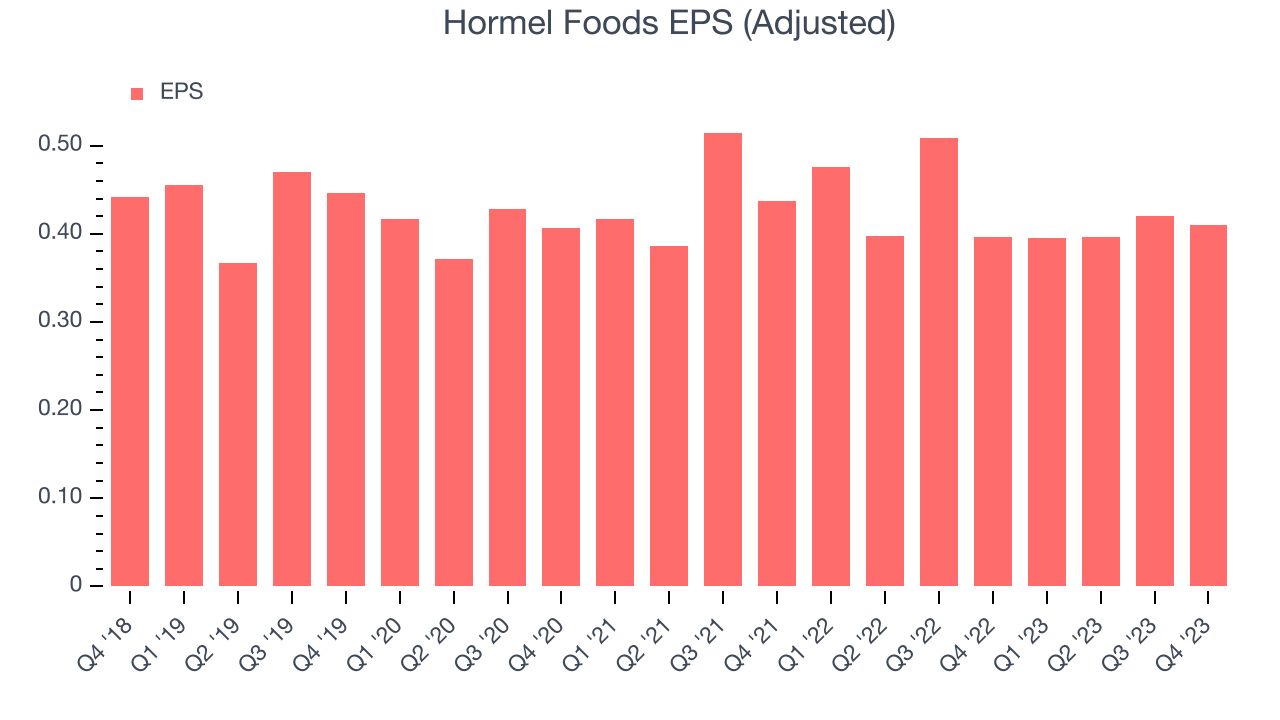
Between FY2021 and FY2024, Hormel Foods's EPS grew 0%, translating into an unimpressive 0% compounded annual growth rate.
Over the next 12 months, however, Wall Street is projecting an average 3% year-on-year decline in EPS.
Cash Is King
Although earnings are undoubtedly valuable for assessing company performance, we believe cash is king because you can't use accounting profits to pay the bills.
Hormel Foods's free cash flow came in at $356.8 million in Q1, up 114% year on year. This result represents a 11.9% margin.
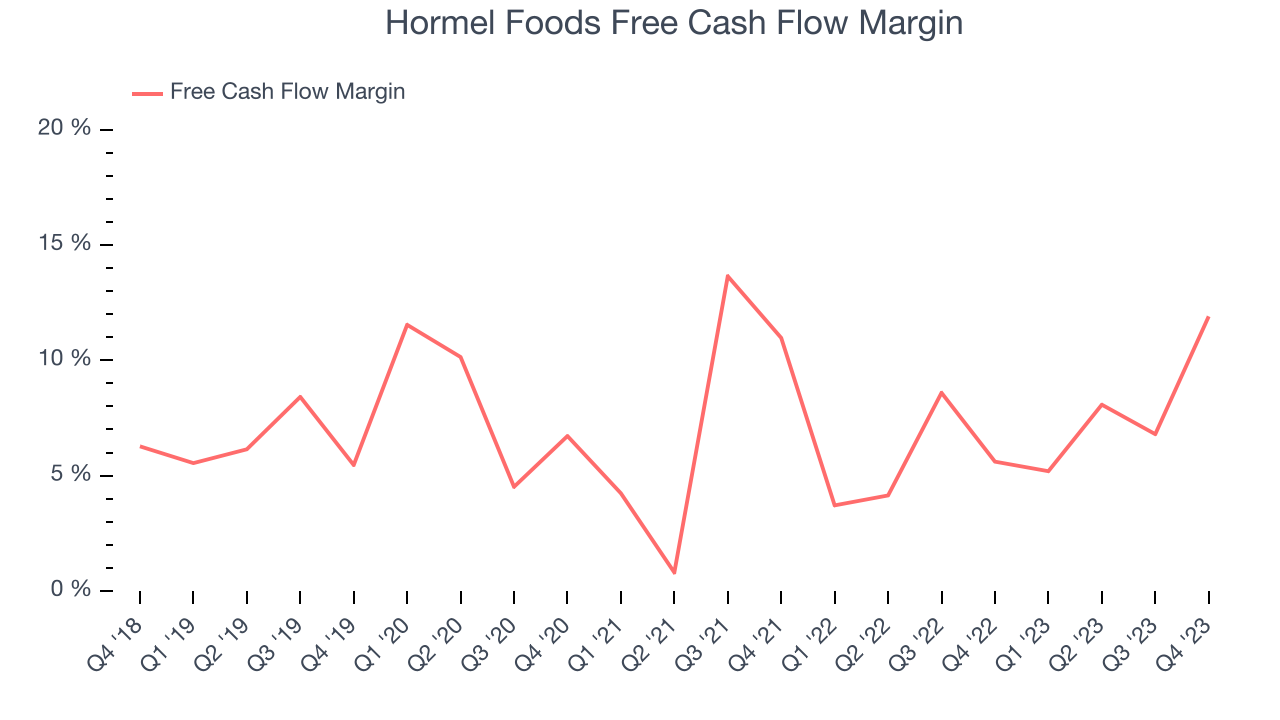
Over the last two years, Hormel Foods has shown decent cash profitability, giving it some reinvestment opportunities. The company's free cash flow margin has averaged 6.8%, slightly better than the broader consumer staples sector. Furthermore, its margin has averaged year-on-year increases of 2.4 percentage points over the last 12 months. This likely pleases the company's investors.
Return on Invested Capital (ROIC)
EPS and free cash flow tell us whether a company was profitable while growing revenue. But was it capital-efficient? Enter ROIC, a metric showing how much operating profit a company generates relative to how much money the business raised (debt and equity).
Hormel Foods's five-year average ROIC was 12.4%, slightly better than the broader sector. Just as you’d like your investment dollars to generate returns, Hormel Foods's invested capital has produced decent profits.
The trend in its ROIC, however, is often what surprises the market and drives the stock price. Unfortunately, Hormel Foods's ROIC over the last two years averaged 6.3 percentage point decreases each year. We like what management has done historically but are concerned its ROIC is declining, perhaps a symptom of waning business opportunities to invest profitably.
Key Takeaways from Hormel Foods's Q1 Results
We enjoyed seeing Hormel Foods exceed analysts' gross margin expectations this quarter. We were also excited its EPS outperformed Wall Street's estimates. While raising guidance after beating a quarter is always icing on the cake, Hormel's maintenance of guidance shows that it's staying on track. Overall, we think this was a really good quarter that should please shareholders. The stock is up 4.8% after reporting and currently trades at $32.28 per share.
Is Now The Time?
Hormel Foods may have had a good quarter, but investors should also consider its valuation and business qualities when assessing the investment opportunity.
We cheer for all companies serving consumers, but in the case of Hormel Foods, we'll be cheering from the sidelines. Although its revenue growth has been decent over the last three years, its shrinking sales volumes suggest it'll need to change its strategy to succeed. And while its well-known brand makes it a household name consumers consistently turn to, the downside is its gross margins make it more challenging to reach positive operating profits compared to other consumer staples businesses.
Hormel Foods's price-to-earnings ratio based on the next 12 months is 19.6x. While the price is reasonable and there are some things to like about Hormel Foods, we think there are better opportunities elsewhere in the market right now.
Wall Street analysts covering the company had a one-year price target of $30.44 per share right before these results (compared to the current share price of $32.28).
To get the best start with StockStory, check out our most recent stock picks, and then sign up to our earnings alerts by adding companies to your watchlist here. We typically have the quarterly earnings results analyzed within seconds of the data being released, and especially for companies reporting pre-market, this often gives investors the chance to react to the results before the market has fully absorbed the information.
